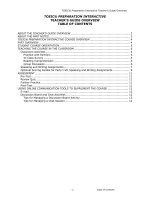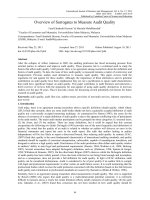Carbon offset overview
Bạn đang xem bản rút gọn của tài liệu. Xem và tải ngay bản đầy đủ của tài liệu tại đây (237.01 KB, 29 trang )
SECTION 4: USING OTHER CRITERIA TO
COMPARE CARBON OFFSETS AND
VENDORS
Purchasers can use a number of other
criteria to evaluate the offsets they buy,
and the vendors they buy from
Offset project type
• Renewable and energy efficiency
projects are most likely to result in
the highest quality offsets
Price
• Offset prices vary from vendor to vendor and by
project type, and also fluctuate with the market
• Higher quality offsets will likely tend to be in the more
expensive price range.
• If there needs to be a trade-off between quality and
quantity, we recommend favouring quality over
quantity, instead of purchasing offsets that might not
have any real climate benefit.
Proportion of offset price going to overhead
• Some offset
vendors provide
information about
how much of their
revenue goes to
the offset projects
themselves, and
how much goes to
overhead
Self-reported
May be not accuracy
Public education
• Vendors have the opportunity to use their websites
and promotional material to educate customers about
the causes of climate change and the ways they can
reduce their carbon footprint
Organizational structure of offset vendors
Non- Profit
Profit
• Others might see the
• Some purchasers might
be more comfortable
with the money devoted
to a voluntary initiative
going to a non-profit
organization
greater participation of
profit-driven
organizations in the
field of carbon offsets
as a way to promote
competition and market
efficiency
Vendor transparency
• Vendors should be highly transparent about their
offsets and their operations.
services
The proportion
of their offset
price that goes
to overhead
Staff and
executive team
Organizational
structure
Contact detail
Carbon calculators
Carbon calculators are an
important aspect of selling
offsets, because purchasers
often use the calculators offered
by the vendor to determine the
quantity of offsets they are going
to purchase.
It is therefore important that these
calculators be easy to use and
provide accurate results by using
accepted methodologies.
Carbon offset project location
Benefits of buying offsets from
projects located in Canada
Benefits of buying offsets from projects located in
developing countries
• Canadians are among the
highest per-capita emitters of
greenhouse gas emissions
• Have the potential to
educate Canadians about
climate change solutions in
their communities.
• Keeps jobs, technical
expertise, and financial
benefits at home.
• Income from offset sales can provide
financial help to some of the poorest
communities in the world
• Offsets from developing countries
are often less expensive than
domestic offsets.
• Helps support the transition to clean,
renewable energy in those countries
Section 5: survey of carbon offset
vendors
Who
included
• 14 Canadian online retail offset vendors
• 6 popular international online retail (2 U.S, 2 U.K,
1 Australian, 1 German)
• Conducted by the Pembina Institute over
approximately an 18-month period, from January
How
2008 to July 2009
conducted
• 6 assessment criteria: additionally, auditing,
unique ownership, permanence, public education,
How
vendor transparency
assessed
1. Additionally
Full points
For offsets that
meet recognized
offset standard
such as Clean
Development
Mechanism
(CDM) or The
Gold Standard
Mid-range points
Low points
a. For offsets that
used the CDM
additionality tool
outside the CDM
or Gold Standard
process
b. For offsets that
were registered
with the Climate
Action Reserve
and the B.C
Emission Offsets
Regulation
To vendors that
claimed to use
their own
proprietary
standard or
additionality
screens for offsets
Zero
To vendors who
did not use
additionality
testing for their
offsets
Results
• Many of the offset vendors
surveyed are selling offsets
certified to The Gold
Standard or CDM, are
using the CDM additionality
tool outside the CDM process,
or are selling offsets that have
been tested for additionality
through the standardized
procedures of the Climate
Action Reserve…
• A minority of the offset
vendors we surveyed were
still lagging seriously on the
assessment of additionality,
and did not appear to have a
good understanding of the
concept or its importance,
and thus their offsets
present greater risks for
offset purchasers
2. Auditing
• Full points only where 100% of a vendor’s portfolio was
stated by the vendor to be validated and verified by thirdparty auditors.
High percentage of their projects validated by
third-party auditors
Only a few of the offset vendors indicated that
they did not sell offsets that were validated or
verified
3. Unique ownership
Looked The use of public accessible, thirdparty registries that track the
for
ownership and retirement of offsets
Awarded points to vendors based on
the percentage of their offsets that
were posted on these registries
Results
• A growing number of offset vendors are placing their
offsets in publicly accessible registries.
• Many vendors indicated that they intend to use
registries in the future, in some cases saying that
they were in the process of transferring existing
paperwork onto a registry
4. Permanence
Full points
Other cases
To vendors who had offset project
Gave marks to vendors based on the
portfolios that did not include any
proportion of their offset portfolio that
biological carbon sequestration project included biological carbon
sequestration projects
A majority of the offset vendors surveyed have portfolios
that focus on renewable energy and energy efficiency projects
In some cases vendors offered a portfolio of different offset
portfolio types; in others, they noted that they were creating
holdbacks or buffer pools of offsets that were not being sold
5. Vendor transparency
We gave points for offset project information available on a vendor’s website, including:
offset project type and location;
description of technology used (i.e., how reductions are achieved);
the year (vintage) the offsets were created;
how many tonnes of offsets each project produces in one year;
total tonnes of greenhouse gas reductions expected to be achieved by each project;
identification of the validators and verifiers, any offset standards used;
and if offsets are sold on a portfolio basis, which offsets are in the portfolio at the time of
purchase
Results
• Most of the offset vendors in the survey were
making efforts to be transparent about the offsets
they are selling as well as their own operations.
• However, some vendors only indicate on their websites
that they are selling offsets from certain project types
(e.g., renewable energy, or tree planting projects), but do
not list specific projects.
• And many vendor websites do not provide other detailed
information, such as the number of offsets being
generated each year, the total tonnes of reductions
projected
6. Public education
We gave points to vendors, who, through their websites,
made credible attempts to educate the public in three
specific areas:
• (1) the causes of climate change, so that purchasers have
an understanding of the problem that carbon offsets are
meant to address;
• (2) the importance of reducing greenhouse gas emissions
themselves, and not just offsetting, to make it clear that
carbon offsets alone will not solve the problem of human
caused climate change;
• (3) quality issues with respect to carbon offsets, such as
informing customers why “additionality” is so important.
Results
• While most offset vendors provided basic information
about the major causes of climate change and its impact, a
number did not provide any information or access to
resources encouraging individuals and organizations to
reduce their own emissions.
As well, some offset vendors did not provide any
information about high quality offsets, beyond a simple
statement that the offsets they were selling were of high
quality
Weighting of assessment criteria
Based on score , offset vendors are group into three
levels
Section 6 : Developing a strong offset
standard for canada
Any credible Canadian standard should take into
account the following quality criteria
Permanence
Accurate quantification
Unique
ownership
Auditing
Additionality









